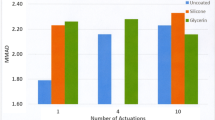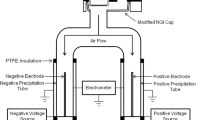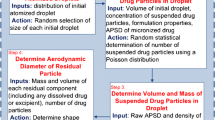Abstract
Purpose
To introduce the design of the electrical Next Generation Impactor (eNGI), and validate its proposed function as a method of electrostatic characterization for pressurized metered dose inhaler (pMDI) formulations.
Methods
Flixotide® (fluticasone propionate), Ventolin® (salbutamol sulphate), and QVAR® (beclomethasone dipropionate) were used as model pMDIs in this study. At an airflow rate of 30 l/min, five individual actuations of each pMDI were introduced into the electrical low-pressure impactor (ELPI), Next Generation Impactor (NGI), and the eNGI. Charge profiles for each actuation were measured by the ELPI and eNGI, while mass profiles were recorded by the all three impactors.
Results
The difference in estimated mass median aerodynamic diameters and geometric standard deviations for all pMDIs using the NGI and eNGI were not found to be statistically significant (p < 0.05). The mean charge profiles from the ELPI and eNGI overlap well between 0.54 and 6.61 μm (Flixotide® and Ventolin®), and between 0.615 and 11.72 μm (QVAR®), where the majority of the impacted doses were collected. Conclusion: For the analysis of pMDIs, the eNGI is comparable to the NGI in measuring particle size distribution, while still being comparable to the ELPI in measuring charge distribution.








Similar content being viewed by others
References
P. C. L. Kwok, and H.-K. Chan. Electrostatic charge in pharmaceutical systems. In J. Swarbrick (ed.), Encyclopedia of Pharmaceutical Technology, Taylor & Francis, London, 2005, pp. 1–14.
M. García-Hernández, P. S. Bagus, and F. Illas. A new analysis of image charge theory. Surf. Sci. 409:69–80 (1998). doi:10.1016/S0039-6028(98)00204-0.
C. Melandri, G. Tarroni, V. Prodi, T. de Zaiacomo, M. Formignani, and C. C. Lombardi. Deposition of charged particles in the human airways. J. Aerosol. Sci. 14:657–669 (1983). doi:10.1016/0021-8502(83)90070-8.
A. G. Bailey, A. H. Hashish, and T. J. Williams. Drug delivery by inhalation of charged particles. J. Electrostat. 44:3–10 (1998). doi:10.1016/S0304-3886(98)00017-5.
W. Balachandran, W. Machowski, E. Gaura, and C. Hudson. Control of drug aerosol in human airways using electrostatic forces. J. Electrostat. 40 & 41:579–584 (1997).
D. Koolpiruck, S. Prakoonwit, and W. Balachandran. Numerical modelling of inhaled charged aerosol deposition in human airways. IEEE Trans. Ind. Appl. 40:1239–1247 (2004). doi:10.1109/TIA.2004.834032.
D. Saini, J. Gunamgari, C. Zulaloglou, R. A. Sims, and M. K. Mazumder. Effect of electrostatic charge and size distributions on respirable aerosol deposition in lung model. In I. I. A. Society (ed.), 39th Annual IAS Meeting (IEEE Industry Applications Society), Vol. 2, IEEE, Seattle, 2004.
A. G. Bailey. Charging of solids and powders. J. Electrostat. 30:167–180 (1993). doi:10.1016/0304-3886(93)90072-F.
M. D. Hogue, C. R. Buhler, C. I. Calle, T. Matsuyama, W. Luo, and E. E. Groop. Insulator–insulator contact charging and its relationship to contact pressure. J. Electrostat. 61:259–268 (2004). doi:10.1016/j.elstat.2004.03.002.
M. Murtomaa, P. Harjunen, V. Mellin, V. Lehto, and E. Laine. Effect of amorphicity on the triboelectrification of lactose powder. J. Electrostat. 56:103–110 (2002). doi:10.1016/S0304-3886(02)00066-9.
D. J. Lacks, and A. Levandovsky. Effect of particle size distribution on the polarity of triboelectric charging in granular insulator systems. J. Electrostat. 65:107–112 (2007). doi:10.1016/j.elstat.2006.07.010.
A. G. Bailey. The charging of insulator surfaces. J. Electrostat. 51–52:82–90 (2001). doi:10.1016/S0304-3886(01)00106-1.
W. Glover, and H. K. Chan. Electrostatic charge characterization of pharmaceutical aerosols using electrical low-pressure impactor (ELPI). J. Aerosol. Sci. 35:755–764 (2004). doi:10.1016/j.jaerosci.2003.12.003.
P. C. L. Kwok, W. Glover, and H. K. Chan. Electrostatic charge characteristics of aerosols produced from metered dose inhalers. J. Pharm. Sci. 94:2789–2799 (2005). doi:10.1002/jps.20395.
P. M. Young, A. Sung, D. Traini, P. Kwok, H. Chiou, and H. K. Chan. Influence of humidity on the electrostatic charge and aerosol performance of dry powder inhalers carrier-based systems. Pharm. Res. 24:963–970 (2007). doi:10.1007/s11095-006-9218-8.
A. G. Bailey. The inhalation and deposition of charged particles within the human lung. J. Electrostat. 42:25–32 (1997). doi:10.1016/S0304-3886(97)00134-4.
P. R. Byron, J. Peart, and J. Staniforth. Aerosol electrostatics I: Properties of fine powders before and after aerosolisation by dry powder inhalers. Pharm. Res. 14:698–705 (1997). doi:10.1023/A:1012181818244.
M. Murtomaa, P. Pekkala, T. Kalliohaka, and J. Paasi. A device for aerosol measurement and sampling. J. Electrostat. 63:571–575 (2005). doi:10.1016/j.elstat.2005.03.018.
M. Dawson, P. Burnell, W. Balachandran, J. Kulon, and S. Sivathasan. A novel bipolar charge measurement system for characterizing aerosols, Respiratory Drug Delivery VIII, Tucson, AZ, USA, 2002, pp. 443–445.
J. Keskinen, K. Pietarinen, and M. Lehtimäki. Electrical low pressure impactor. J. Aerosol. Sci. 23:353–360 (1992). doi:10.1016/0021-8502(92)90004-F.
J. C. Orban, and J. Peart. Simultaneous electrostatic charge characterization and particle size analysis of metered dose inhalers (pMDIs) using the electrical low pressure impactor. Respiratory Drug Delivery IX, 2004.
M. Marjamäki, J. Keskinen, D. R. Chen, and D. Y. H. Pui. Performance evaluation of the electrical low-pressure impactor. J. Aerosol. Sci. 31:249–261 (2000). doi:10.1016/S0021-8502(99)00052-X.
V. A. Marple, D. L. Roberts, F. J. Romay, N. C. Miller, K. G. Truman, M. van Oort, B. Olsson, M. J. Holroyd, J. P. Mitchell, and D. Hochrainer. Next generation pharmaceutical impactor (a new impactor for pharmaceutical inhaler testing). Part I: Design. J. Aerosol. Med. 16:283–299 (2003). doi:10.1089/089426803769017659.
C. Dunbar, and J. Mitchell. Analysis of cascade impactor mass distributions. J. Aerosol. Med. 18:439–451 (2005). doi:10.1089/jam.2005.18.439.
Acknowledgments
The authors would like to acknowledge Michael Paterson, Terry Pfeiffer and Herbert Chiou for their technical advice and expertise in assisting the construction of the eNGI, and Philip Kwok for his advice on the ELPI.
Author information
Authors and Affiliations
Corresponding author
Rights and permissions
About this article
Cite this article
Hoe, S., Young, P.M., Chan, HK. et al. Introduction of the Electrical Next Generation Impactor (eNGI) and Investigation of its Capabilities for the Study of Pressurized Metered Dose Inhalers. Pharm Res 26, 431–437 (2009). https://doi.org/10.1007/s11095-008-9761-6
Received:
Accepted:
Published:
Issue Date:
DOI: https://doi.org/10.1007/s11095-008-9761-6




